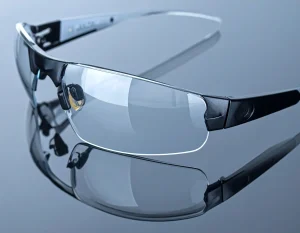The typical adjustment timeline
Adjusting to new glasses is a unique experience for everyone. The majority of us require 2 – 14 days for our eyes to feel right. The usual adjustment period is a couple days to a couple weeks. For most, it’s only a day or two, but it can extend to a week or more if you’ve never worn glasses. We watch first-timers frequently require all of that two weeks.
Adults over 40 may need a few weeks of adjustment, primarily because of the natural evolution of our eyesight as we age. The primary cause for this range is the manner in which our eyes and brain process vision together. When you slip on a fresh pair of glasses – whether they’re from our private-designer line or a timeless classic – the lenses alter the way light strikes your eyes.
Even small prescription adjustments, such as a slight increase in power, can take a few days to adjust. If your prescription has changed significantly, then anticipate your eyes having to exert more effort and therefore more time. For instance, a person transitioning to progressive lenses or to lenses with blue light filters may notice that things appear strange initially – lines might feel warped, or the world slightly off-kilter. This is natural. Our brains are speedy, but they might lag behind.
During this adjustment period, it’s common to experience headaches, mild eye strain, or some dizziness, particularly when looking around or up and down. Our suggestion – take your time. Wear your new glasses as much as you can each day, but give your eyes little breaks if necessary. We constantly remind clients that patience is everything.
It’s easy to measure your own experience against others, but each pair of eyes is different. Push with your new prescription, even if it feels weird. It’s what motivates us to think of you for that crystal clear, perfect fit look, but even the most innovative technological lenses need a little human waiting.
If symptoms seem severe or persist beyond two weeks, it’s worth consulting. At times, continued discomfort indicates the prescription or fit requires a fast adjustment. We provide complimentary adjustments and support at the ready, from simple slips to more intricate challenges, so you’re never left stranded.
We strive to make this transition as seamless as possible – service with a smile, convenient direct billing and rapid repair options are always at hand.

Why your brain feels strange
When we get new eyeglasses our brains take a while to readjust and acclimate to the new stimuli. Even if the dosage is identical, all sorts of things can seem strange initially. That’s because our brains had gotten used to the old lenses, even if they were no longer perfect. The crispness of new lenses, particularly when equipped with the latest technology, can almost feel too crisp.
Our eyes and brains are quite the tag team, and it’s a little while for them to come back in agreement about what “normal” looks like. Most individuals adapt to new glasses in a couple of days, others can take a few weeks. In the meantime, it’s common to experience slight blurriness, eye fatigue, or even the infamous ‘fishbowl effect’.
This occurs as the brain is occupied with integrating its newly perceived images, causing the world to bend or warp around the periphery, rendering them odd or distorted. This is just part of the process, particularly with stronger prescriptions or fresh lens contours. We experience this all the time, and it always passes.
Depth perception is yet another thing that may feel off. Our brains rely on subtle visual cues to determine distance, and even a slight change in lens power or frame shape can disrupt this. All at once, the coffee cup on the table may feel just slightly closer or farther than you anticipate.
This can render routine activities such as climbing stairs or filling a glass of water to seem strange for a day or two. Peripheral vision may feel weird as your brain adapts to how the new lenses bend light differently at the edges. For people with astigmatism, the adaptation time is typically the same – a few days to 2 weeks.
The trick is to get into wearing your new glasses at every opportunity. Alternating between your old and new glasses muddles this process, impeding your brain’s ability to adapt to the new normal. We often suggest practicing the 20-20-20 rule: every 20 minutes, look at something 20 feet away for 20 seconds.
This easy practice alleviates eye strain and accelerates your adaptation. Mild disorientation or visual strain, of course, is normal, but it doesn’t last. With regular wear and a bit of patience, the brain adjusts.
Common adjustment symptoms
When we begin wearing new glasses, it’s common to experience some initial alteration as our eyes and brain adjust to interpreting new impulses. Almost everyone has some discomfort initially, even with advanced technology lenses or a personalized fit from a committed full-service eye exam. These symptoms can be unnerving, but they’re a normal stage in the adjustment process and indicate that the eyes are figuring out how to adjust to the new prescription.
Headaches can be one of the most common symptoms in the initial days. Our eyes exert themselves to adjust to the new lens strength/positioning, taxing the muscles surrounding our eyes and forehead. This is particularly the case if it’s the initial wear of glasses, or a significant prescription change.
Most of us experience some small amount of blurriness, intermittent and especially when shifting focus from near to far objects. For others, there’s a mild fishbowl effect – straight lines appear slightly curved, or things at the periphery of our vision appear to bend. This is more typical with high prescriptions or with progressive lenses. The experience generally dissipates once your brain acclimates, but can be a nuisance initially.
Dizziness and eye strain are common. Our equilibrium and depth perception is thrown off as our eyes relearn to judge distances through new lenses. Something as simple as walking downstairs or grabbing a cup might feel wonky and the world appears to shake as we move our head.
This occurs because the new glasses are transmitting new signals to your brain, which must reorient to this stimulus. So it’s great to take it slow and provide our eyes with regular rest breaks – particularly in week one. Brief breaks during the day alleviate the pain and accelerate the adjustment.
Depth perception may seem a little off at first. Judging distances or the height of steps can be more difficult than anticipated. This is a typical gripe, particularly with multifocal or strong prescriptions.
We tell most of our clients that exercises like grasping or lazy walking around the house help the eyes to recover more quickly. Most symptoms only last a few days, usually clearing up within two to three. If there’s a major prescription change, the adjustment can extend to one or two weeks.
If headaches, dizziness, or blurred vision persist beyond this, it might indicate that the prescription or lens fit should be re-evaluated. We advocate a return visit if symptoms persist, as comfort and sharp vision are always our objectives.

How to adapt faster
Getting used to new glasses isn’t as simple as wearing them and waiting for your eyes to adjust. Our management of those initial couple days with new lenses can significantly impact our adaptation speed. Most people get used to it in a week or two but a small number discover it requires three weeks, particularly with progressive lenses.
We always tell our clients that there are steps that make this time easier and less stressful. Simply by strapping new glasses on all day, not just a couple hours, we train our brains to see new images faster. The more we employ them, the more quickly our eyes and brain collaborate to adjust.
If the prescription is very mild or you’re already used to eyeglasses, you may get comfortable within a few days. For big adjustments or newbies, particularly with progressives, patience is the name of the game. So as to not elongate the adjustment, we suggest not switching back to old glasses. Switching, instead, confuses the brain and elongates the adaptation process.
Keeping those lenses clean and clear is a small step that pays off. Smudges, dirt and dust make the eyes have to work harder to focus, which leads to strain. A fast wipe with the proper cloth and solution will maintain clear, comfortable vision.
Whether it’s designer frames or bleeding edge lens tech, a clean lens reveals the actual clarity of the prescription. For our returning visitors, we provide complimentary adjustments and cleaning, ensuring your fit and vision remains perfect.
Glancing through various segments of the lens, particularly for first-time users of progressive lenses, is key. We recommend that clients experiment shifting their eyes to explore the different vision zones – such as reading down, looking long through the top, and attempting side peeks – without moving the head.
This aids eye training in the proper usage of the full extent of the lenses. It might seem strange in the beginning, but if you make a habit of doing this during routine activities, such as reading or taking a walk, you’ll accelerate the process.
For anyone feeling strain, the 20-20-20 rule is simple and effective: every 20 minutes, look at something 20 feet away for 20 seconds. This provides your eyes a break, particularly if work involves staring at screens all day.
So do gentle eye exercises – such as shutting the eyes for a minute or doing slow eyeball rolls. We advise clients to accrue wear time if they have trouble – beginning with a few hours and extending each day.
If pain – such as headaches, blurry vision or eye strain – persists for over two weeks, it’s time to consult with us or another eye care professional. Every now and then, a little fine tuning is all it takes, and we’re here to assist.

The overlooked role of frames
Selecting the perfect frames is more than just selecting a style – it’s about ensuring your spectacles are comfortable, secure and assist your vision daily. When we speak to clients about adapting to new glasses, we never fail to mention to them the important role frames play. Even if you have state-of-the-art lenses, the wrong frames can stall your transition and make the entire experience less enjoyable than it needs to be.
Fit is the initial aspect they examine. Good-fitting frames won’t squeeze your nose or chafe behind your ears. A frame too tight gives you headaches, too loose slips down and requires constant adjusting. That’s why we don’t think twice about taking an extra moment to fit frames just right, providing free adjustments as a service.
If frames sit crooked or don’t hug the face well, they can even cause a slight tilt in your vision, which results in that weird dizzy sensation some experience with new glasses. For clients who switch to larger or smaller frames, it can take a couple days longer for the brain to adapt to where those edges now rest. This makes sense, but it’s something we always warn people about.
Weight is another detail that matters more than most people realize. Such lightweight frames, often constructed from new metals or premium plastics, exert less tension on your nose and ears. Heavier frames can feel substantial, but by the end of the day, they can cause red marks or irritation.
If you have high-powered prescriptions and thick lenses, a lighter frame can make all the difference in comfort. We have our clients experiment with a bunch – occasionally a frame that looks great is too heavy after a few minutes, and you only become aware of this when you wear it for a while.
Style and design do more than make a statement. Thicker rims and wider arms can obstruct some of your peripheral vision – particularly if you wear progressives or multifocals. Certain styles, such as wraparounds or deep rectangles, can provide a slight “fishbowl” effect until your eyes adapt to the new shape in your vision.
We encounter this the most with clients who change frame shapes or sizes. Additionally, some styles have a superior hold to the face and don’t slide as much, which is critical for active individuals or parents selecting eyewear for their children.
Getting used to new frames isn’t just visual – it’s how the glasses fit, how the weight feels, how the style suits your lifestyle. We urge our clients to be slow with this decision, and depend on our staff to help them customize, modify and direct them to the perfect match.

When to call your optometrist
We all assume some slight blurriness or eye strain when we begin wearing new glasses, but there are moments when picking up the phone to call your optometrist is the right decision for your eyes. If your vision remains blurry and doesn’t resolve after a few days, this may indicate that your prescription is off. Occasionally, even a minor adjustment in your lenses can take some acclimating, but if the blur lingers or clears only intermittently, that’s a call to check in.
We know from experience that a prescription error, frame misalignment or lens defect can all cause these issues, and a quick look can save you days of frustration.
Headaches is another new glasses frequent flyer. Most experience mild irritation initially, but if you experience pounding headaches each time you slide your specs on – particularly within minutes – the fit or prescription could be awry. Glasses that pinch behind your ears or sit too tight on your nose can cause headaches that linger.
We suggest you stop in for an adjustment or fit check – we provide free repair and fitting! We wish you could wear your glasses all day, comfortably.
Dizziness and eye strain can be signs of trouble, especially if you’re still feeling them after following the 20-20-20 rule (taking breaks every 20 minutes to look at something 20 feet away for 20 seconds). If you’re experiencing that “fishbowl effect” – look at the edges of your vision and everything appears curved or warped – that persists for more than a week, give us a call.
These symptoms can indicate your eyes are struggling to adjust, or the lenses require an accuracy check.
If you experience symptoms like sudden loss of vision, flashes of light, or new, persistent dark spots, call your optometrist immediately. These can be symptoms of something more urgent. Even with a significant prescription change, you should anticipate things evening out within a few weeks.
If they don’t, a comprehensive eye exam with your optometrist is the best way to eliminate underlying issues.
When all else fails, contact. No one should suffer with glasses that don’t fit or continually hurt. We’re here for prescription reviews, tweaks and any eyewear questions, ensuring you experience crystal clear vision and a comfortable fit each day.












